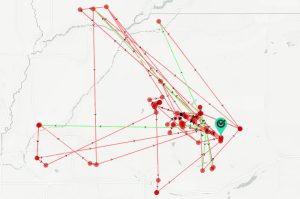When it comes to containing swine disease, the faster you identify the people and vehicle movements connected to a facility, the more likely you are to take effective action to stop the spread. Research confirms this point: “A good monitoring system should provide fast tracking of disease outbreaks and assist decision makers in understanding and explaining disease dynamics and spreading patterns.”1
Speed matters in an outbreak
In the US, PRRS is estimated to have caused annual losses of around $1.2 billion2 from 2016 to 2020; the 2014 PED outbreak is estimated to have resulted in a loss of approximately $1 billion.3
A faster outbreak response will reduce transmission which reduces the number of farms affected and the risk of additional financial losses. The figures below illustrate the dramatic impact of stopping disease at even one node of transmission.4
Disease spread with no intervention

Stopping disease spread at even one or two nodes will prevent transmission to multiple other sites.

Trace-outs and instant network communication

A mathematical modeling study using real animal movement data showed that contact tracing was the best intervention for disease control. Contact tracing resulted in 95% disease control, outperforming all the other strategies used in the model.5
Generating reports with real-time contact trace-outs is crucial for fast, effective response to reduce transmission and minimize disease impact. More often than not though, one of the lengthiest and most onerous parts of a disease investigation is finding out who travelled to what farm and where they went to next. It may take days to manually gather the information through phone calls, emails, texts, and paper logbooks.
Farm Health Guardian (FHG) digital technology provides complete access to this data in minutes, via a trace-out report and map generated by the software. FHG combines real-time truck, people and visitor records into a cloud hosted, secure database that enables rapid animal disease trace-outs. Using the technology to conduct disease investigations ensures accuracy and greatly improves the confidence of the information.
In app instant messaging
 In the event of a suspect outbreak, the swine company veterinarian or animal health manager can generate a trace-out report that lists the properties, vehicles and people who had primary and secondary contact with the index farm. Contact information is also included in the trace-out report, which can then be used to send disease risk alerts via direct message through the Farm Health Guardian app. Heightened biosecurity measures can be communicated in real-time with a network to limit the spread between farms.
In the event of a suspect outbreak, the swine company veterinarian or animal health manager can generate a trace-out report that lists the properties, vehicles and people who had primary and secondary contact with the index farm. Contact information is also included in the trace-out report, which can then be used to send disease risk alerts via direct message through the Farm Health Guardian app. Heightened biosecurity measures can be communicated in real-time with a network to limit the spread between farms.
The message itself can include health status changes, instructions for longer downtime requirements or notifications to lockdown or limit movement into a property.
Update farm health status in real-time
For farm health status, Farm Health Guardian simplifies management and verification of downtime between properties, making it easy for users to determine if they are clear to visit a site.
Health statuses for each property in a network can include farm type, flow, and disease information. Once a health status is assigned to a property, both the color and status will appear on the property list in the software. The corresponding color will also be displayed on the property map. When hovering over a property in the Farm Health Guardian app, the name, health status, and type of property will be shown.
If a user attempts to visit a site without meeting the biosecurity requirements, managers or health staff will be notified of the breach.
When the health status of a property is changed, its relationship with all other properties is automatically updated. Real-time updates eliminate the need for bulky spreadsheets and complicated procedures, streamlining the process and protecting against disease spread during an outbreak.
Early detection and action are key to containing disease and limiting its spread. Farm Health Guardian’s digital biosecurity tools manage disease in motion, making disease response more efficient and effective.
1 https://www.frontiersin.org/articles/10.3389/fvets.2021.676661/full
2 https://research.iastate.edu/2024/07/30/growing-losses-from-prrs-cost-pork-producers-1-2-billion-per-year-new-study-shows/
3 https://www.sciencedirect.com/science/article/abs/pii/S0167587716303890
4 Dr. Bruce McNab, Animal Health & Welfare Branch, Ontario Ministry of Agriculture, Food & Rural Affairs

